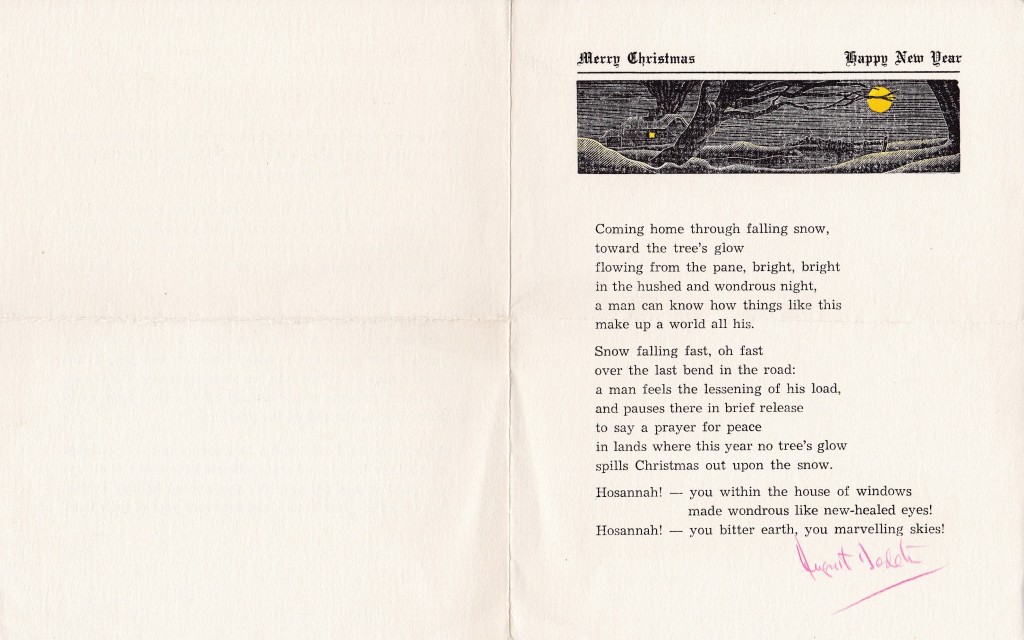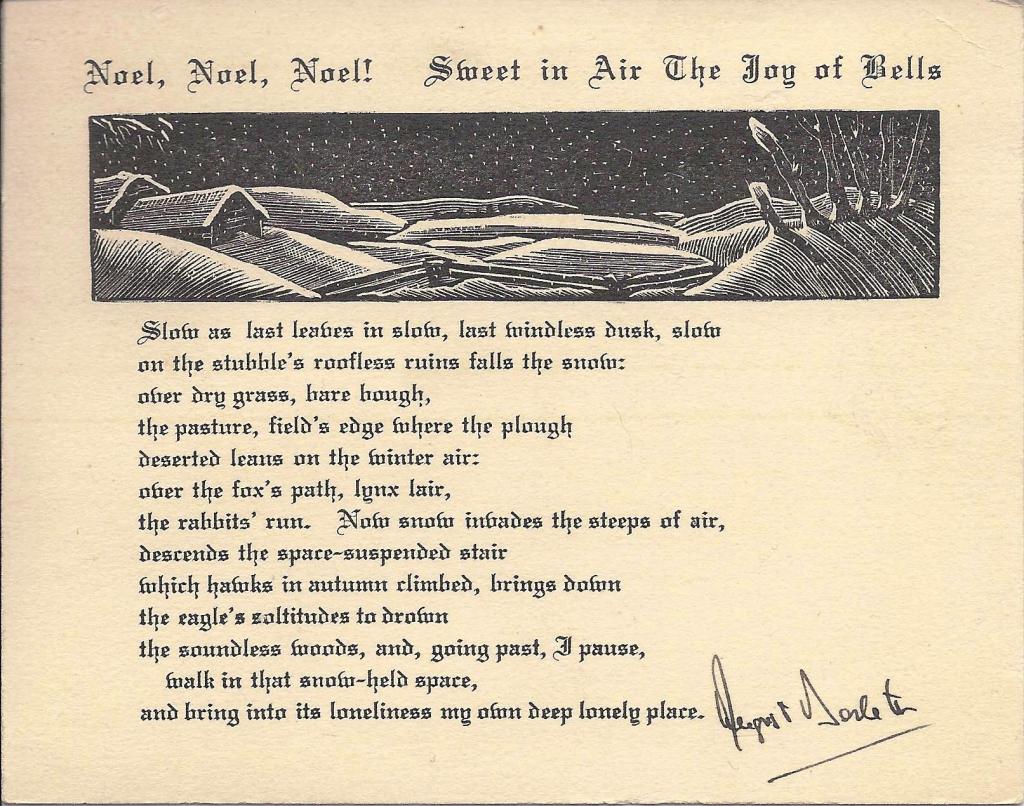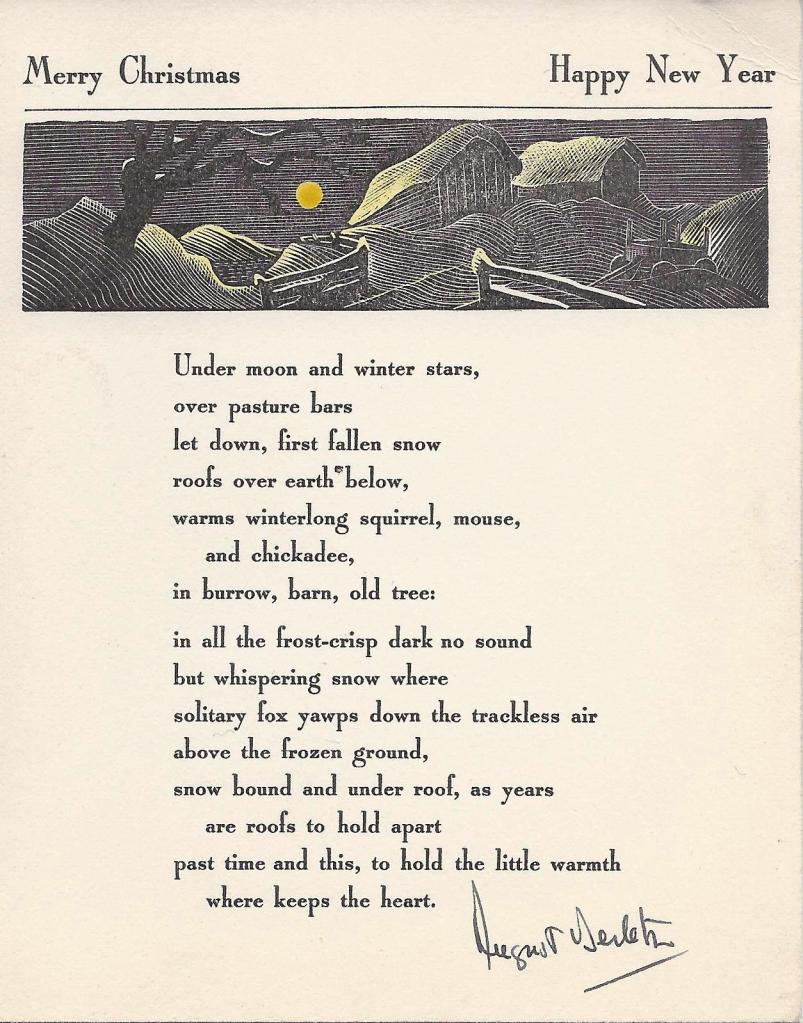
To all my friends and acquaintances … the last card I shall send out.
Years ago on this Allied Authors website in “A Derleth Christmas Card,” I touted an unexpected find I made in a local antique store: a series of unique Christmas cards issued by Wisconsin’s famous author — and close friend of Allied Authors — August Derleth.
Unexpected, because even in his home state, Derleth’s proverbial backyard, such finds are fewer and farther between, with his fame continuing to grow.
Admittedly, the title of that brief notice — intimating one card only — may have misled the reader who failed to canvas the entire page, which described the distinct family of cards I found — each exhibiting a new poem by Derleth and each a new illustration by Derleth’s friend, Wisconsin artist Frank Utpatel.
Reproduced from woodcuts, Utpatel’s panoramas are hallmark. Black and white country views, shadowy, textured, stamped onto white paper backgrounds — each delineating the “silent nights” of a typical Wisconsin winter.
Regarding the expressive poems, I hazarded how for a period of years…
Derleth chose one he newly favored for inspiration, composed a new Christmas/New Year poem, and then stamped these onto heavy stock paper to give as a holiday greeting. Derleth personalized each by signing them individually and adding a few warm patches of yellow [or orange] moonlight.
To be accurate, not every card has a crayon or marker highlight on Utpatel’s illustration. It is missing from two that I found, but the other three, it always seemed to me, were made more seasonally appropriate because of this added touch of warmth.
Above the illustration, Derleth’s personal year-end greeting. Below, the holiday stanzas, suited to both premise and scene. “Cabinet”-sized for stand-up display, approximately 5-3/8″ x 4-1/4″, printed one-sided only. The two lacking Derleth’s highlight were landscape oriented; the others, portrait.
And near the bottom, added to every card, Derleth’s carefully executed signature.

I knew immediately that the Derleth-Utpatel cards were rare — components of some little-known subset of the many item-categories associated with August Derleth, all assiduously collected. And only discovered because I had been searching for the author’s publishing ephemera, including the professionally printed catalogs, brochures, and stock lists Derleth distributed free to the patrons of Arkham House, Mycroft & Moran, Stanton & Lee, and Hawk & Whippoorwill.
Knowledgeable fans of Derleth believed the cards were products of the ’60s, even as I stubbornly insisted the signatures looked more like those from early in his career, as in the older books on my shelves. No one knew how many years he did these, but I was sure that one day we would discover the number of different cards there were (not something a recipient would be apt to casually toss out), as well as how many of each had been printed, the true indicator of how rare one or another of the cards might be.
Recently, a new card did turn up, though printed on thin paper and measuring 6-5/8″ x 10-5/8.” And yet, in its important aspects, it was the same ilk, from the same series, a remarkable card that provided, circumstantially, what I needed to piece together their history.
Six cards, I deduced, comprise the entire series — a safe conclusion, despite similar cards Derleth created, especially during the heady early days of his career. The author’s Christmas card for 1935, as example (pictured occasionally in the August Derleth Society Newsletter, the official organ of the fanbase today), featured the frontispiece from Place of Hawks, Derleth’s newest book that year.
Derleth’s plan for the new card I found — and the reason for the thin paper — allowed him to mail them all folded, in a separate envelope. The heavier paper used for the other five, a blank side available for address and postage, made them suitable for traveling the U.S. Mail system, as a postcard for only a 1-cent stamp.
Why, then, would Derleth pay 3 cents apiece to envelope all of No. 6? Because he used the blank side for the personal message that began ominously, “To all My Friends … the last card I shall send out.”
Four paragraphs to explain: “From one hundred cards a few years ago to many hundreds this year … at this rate, ten years from now, the Christmas card problem, would occupy all my time from early November to the end of the year.” And, in conclusion, to offer friends and acquaintances “good wishes not only for this annual holiday season, but for all the year ’round, and for every year of their lives.”
Obviously, card No. 6 was the last in the series (the reason I have always referred to it as No. 6, even though the order of the other five had yet to be decided), which also intimated that Derleth himself viewed the group as distinct.
From card No. 6, we also learn this important fact: there were 100 copies of card No 1.
Unfortunately, as with the others, I had nothing that gave up the year card No. 6 went out.
But, like the card itself, the answer to that key question popped up unexpectedly, serendipitously, in an old booklet I was glancing through: Catalog 6, Modern Literature, issued ca. 1972 by bookseller Roy A. Squires.
For sale, a copy of Derleth’s poetry collection, Rind of the Earth, with an added bonus:
Laid in is a folded leaflet, Derleth’s Christmas card, with an Utpatel illustration, a poem (which appears in the book), and a message including the statement that this “…is the last card I shall send out.” Signed in ink; in original envelope, postmarked Dec. 16, 1941.
Card No. 6, Christmas 1941!
A recent collection of Derleth’s verse, a poem selected for the greeting, another of the author’s early signatures; all fell sensibly into place. Comparing Derleth’s earlier poetry collections to the other five cards confirmed how each had heralded a recent, or forthcoming, volume of his poetry. With 1935 out of the running, the 1936–41 span fit perfectly — six cards over six years — listed here for the first time, poem and collection, numbered in order:
- December 1936 introduced the poem titled “Time Being Winter,” collected in Hawk on the Wind (1938).
- December 1937 introduced “Lonely Place,” collected in Man Track Here (1939).
- December 1938 introduced “Winter Moon,” collected in Man Track Here (1939).
- December 1939 introduced “Roofs,” collected in Here on a Darkling Plain (1940).
- December 1940 introduced “Two Variations on a Theme” but included only the first of these studies subtitled “Christmas,” collected in Rind of Earth (1942).
- December 1941 introduced “Tree in the Window,” the second variation from the same collection

Odd clues I had previously logged now fit the pattern like pieces in a puzzle. A 1937 reference in Derleth’s correspondence to cards printed at the News, where the author routinely purchased stationery items, the latest American Mercury, and the local newspaper by proprietor Bert Giegerich. Back then his ad ran:
Founded in 1876 — “Eight Big Pages Every Week” — The Sauk County News in Prairie du Sac
Besides the News, Bert promoted “quality job printing and new or used office equipment.”
Another clue I found in a 1993 August Derleth Society Newsletter back-issue, a prepublication announcement for a six-card set of Derleth Christmas card reprints, for $5.00 plus $2.00 shipping & handling.
Six!
An offer never repeated, the set probably never printed.
Still, new evidence could turn up to alter my conclusions above. Dating of the woodcuts, for example, might throw off the timeline. Although it is logical to assume Derleth fashioned a different card for each of the six years, it is possible he issued two in the Christmas seasons where the same collection was sourced; however, the more logical explanation is that happened only when a newer collection had not been published.
There is also a letter dated December 17, 1942, a correspondent telling Derleth: “I picked up one of your Utpatel-Derleth cards at Moseley’s to send to a friend.” What does it mean, I wonder, if the cards had also been sold at a bookstore located at 10 East Mifflin Street in Madison? Did Derleth have a commercial angle? And if he printed extras to sell locally that never caught on, never became lucrative, was that the reason he pulled the plug?
Or did Derleth simply change his writing emphasis? Other than homages to Thoreau, 1943 and 1944 came and went without new poetry collections.
Even with the mystery solved, these niggling questions remain…

John D. Haefele contributed this article.
© John D. Haefele. All rights reserved.

June 20th, 2021 at 11:31 pm
[…] (Allied Authors): Years ago on this Allied Authors website in “A Derleth Christmas Card,” I touted an […]